Citation: Jingwen Zhang, Lu Wang, Huolin Chen, Tieying Yin, Yanqun Teng, Kang Zhang, Donghong Yu, Guixue Wang. Effect of Caspase Inhibitor Ac-DEVD-CHO on Apoptosis of Vascular Smooth Muscle Cells Induced by Artesunate[J]. AIMS Bioengineering, 2014, 1(1): 13-24. doi: 10.3934/bioeng.2014.1.13
| [1] | Guang Long, Bo Lin, Lu Wang, Lingyan Wu, Tieying Yin, Donghong Yu, Guixue Wang . Sappan Lignum Extract Inhibits Restenosis in the Injured Artery through the Deactivation of Nuclear Factor-κB. AIMS Bioengineering, 2014, 1(1): 25-39. doi: 10.3934/bioeng.2014.1.25 |
| [2] | Firoz Ahmed . Deciphering the gene regulatory network associated with anti-apoptosis in the pancreatic islets of type 2 diabetes mice using computational approaches. AIMS Bioengineering, 2023, 10(2): 111-140. doi: 10.3934/bioeng.2023009 |
| [3] | Takashi Nakazawa, Sohei Tasaki, Kiyohiko Nakai, Takashi Suzuki . Multicellular model of angiogenesis. AIMS Bioengineering, 2022, 9(1): 44-60. doi: 10.3934/bioeng.2022004 |
| [4] | Yihan Zhang . Manufacture of complex heart tissues: technological advancements and future directions. AIMS Bioengineering, 2021, 8(1): 73-92. doi: 10.3934/bioeng.2021008 |
| [5] | Satoshi Migita, Kunitaka Araki . Effect of nanometer scale surface roughness of titanium for osteoblast function. AIMS Bioengineering, 2017, 4(1): 162-170. doi: 10.3934/bioeng.2017.1.162 |
| [6] | Caroline Rhim, William E. Kraus, George A. Truskey . Biomechanical effects on microRNA expression in skeletal muscle differentiation. AIMS Bioengineering, 2020, 7(3): 147-164. doi: 10.3934/bioeng.2020014 |
| [7] | Sven Sölmann, Anke Rattenholl, Hannah Blattner, Guido Ehrmann, Frank Gudermann, Dirk Lütkemeyer, Andrea Ehrmann . Mammalian cell adhesion on different 3D printed polymers with varying sterilization methods and acidic treatment. AIMS Bioengineering, 2021, 8(1): 25-35. doi: 10.3934/bioeng.2021004 |
| [8] | Sayuri Yoshikawa, Kurumi Taniguchi, Haruka Sawamura, Yuka Ikeda, Ai Tsuji, Satoru Matsuda . Promising probiotics for the treatment of nephrotoxicity induced during immune-checkpoint therapy against cancers. AIMS Bioengineering, 2022, 9(3): 283-292. doi: 10.3934/bioeng.2022019 |
| [9] | Daniel Pelaez, John H. Michel, Herman S. Cheung . Growth on elastic silicone substrate elicits a partial myogenic response in periodontal ligament derived stem cells. AIMS Bioengineering, 2016, 3(4): 515-527. doi: 10.3934/bioeng.2016.4.515 |
| [10] | Carlos M. Carballosa, Jordan M. Greenberg, Herman S. Cheung . Expression and function of nicotinic acetylcholine receptors in stem cells. AIMS Bioengineering, 2016, 3(3): 245-263. doi: 10.3934/bioeng.2016.3.245 |
Abbreviations list:
MTT = Methyl thiazolyl tetrazolium; TEM = Transmission electron microscopy; RS = Restenosis; VSMCs = Vascular smooth muscle cells; DMEM = Dulbecco's modified Eagle's medium; SDS-PAGE = Sodium dodecyl sulfate polyacrylamide gel electrophoresis; Ac-DEVD-CHO = N-acetyl-L-α-aspartyl-L-α-glutamyl-N-(2-carboxyl-1-formylethyl)-L-valinamide; OD = Absorbance value (optical density); PBS = Phosphate-buffered saline.
Coronary angioplasty implantation is one of the primary methods of treating coronary heart diseases. However, the high postoperative restenosis (RS) rate has hampered its development. Numerous studies have shown that RS is related to thrombosis, intimal hyperplasia, vascular remodeling, on which the proliferation and apoptosis of vascular smooth muscle cells (VSMCs have profound impacts [1,2,3]. Therefore understanding the mechanism underlying VSMCs proliferation and apoptosis research on this topic will hence help to identify the causes of atherosclerosis and the etiopathogenesis of RS as well as its control strategies.
Being a derivative of artemisinin, artesunate is one of the sesquiterpenoids possessing peroxide structure. Based on the high efficiency and low toxicity, it has become a new type of antimalarial drug universally applied in clinical practice. It has various pharmacological effects with the treatment of schistosomiasis, immune regulation, and anti-tumor [4]. In addition to its role in inhibiting VSMC proliferation and promoting apoptosis, the study has revealed that Artesunate also has inhibitory effects on the RS-induced vascular remodeling [5]. Recently, some studies have shown that Artesunate still have antitumor, and antiangiogenetic activities; it also prevents and cures schistosomiasis and regulates immunity, in addition to other effects [6,7,8], by changing the apoptotic signaling molecule, such as bax/bcl-2, and apoptotic protein, such as NF-κB p65/caspase-3, expression to strongly inhibit the proliferation and apoptosis of multifarious cells, especially the tumor cells [9,10,11,12]. As a type of Chinese medicine with high efficiency, low toxicity and low cost as well as its low potential to produce drug resistance, Artesunate is hopefully another important drug for drug-eluting stents, following rapamycin and paclitaxel. Meanwhile, the synergistic effects brought by the combined use of Artesunate and other drugs, which not only greatly enhance the effects of the drug action, but also considerably widen the scope of its application, also have increasingly drawn our attention [13,14]. Thus, studies focused upon the effects and regulatory mechanisms of Artesunate will provide a strong scientific basis and inspiration for the expansion of its clinical applications. In order to further studies on the VSMCs growth and the mechanism of action, we took advantages of rabbit aortic smooth muscle cell lines, methyl thiazolyl tetrazolium (MTT), transmission electron microscopy (TEM), and flow cytometry to explore the Artesunate’s effects on vascular smooth muscle cells (VSMCs) proliferation and apoptosis. Since caspase-3 is a key apoptotic protease in the caspase pathway, and one of the major apoptosis executors [15]. We also used Western blot to test of content of caspase-3, by the changes in the expression level of the apoptosis protein with addition to caspase-3 inhibitor Ac-DEVD-CHO, to investigate the effect of Artesunate on VSMCs apoptosis and its regulatory mechanism.
The rabbit aortic smooth muscle cell strain was obtained from the Cell Center of Institute of Basic Medical Sciences, Chinese Academy of Medical Sciences, which was conventionally cultured in complete Dulbecco's modified Eagle's medium (DMEM) (containing 10 % fetal calf serum, 100 u/mL penicillin, and 100 μg/mL streptomycin, pH 7.2) in an atmosphere containing 5 % CO2 at 37 ℃ in an incubator.
Reagents: Artesunate (Guilin Pharmaceutical Co., Ltd.), DMEM, special grade fetal calf serum (Hyclone Company), propidium iodide (PI), MTT, trypsin (Sigma Company), rabbit antihuman caspase-3 monoclonal antibody, sodium dodecyl sulfate polyacrylamide gel electrophoresis (SDS-PAGE) preparation kit, caspase-3 inhibitor N-acetyl-L-α-aspartyl-L-α-glutamyl-N-(2-carboxyl-1-formylethyl)-L-valinamide(Ac-DEVD-CHO; Biyuntian Company), and horseradish peroxidase– labeled goat antirabbit secondary antibody (Beijing Zhongshan Company). Instruments: enzyme immunoassay meter (AP-960), Transmission electron microscope (Hitachi H-600), Flow cytometry (BD FACSCalibur), Gel imaging system (Alpha Company).
VSMCs in their logarithmic phase were routinely digested and a cell suspension containing 5.0 × 104 cells/mL was prepared, with complete DMEM containing 10 % fetal bovine serum. Subsequently, 100 μL of cell suspension was inoculated into each well, and incubated overnight at 37 ℃, under 5 % CO2 in an incubator. The culture solution was aspirated, 200 μL of Artesunate was added to the DMEM culture solution in each well at concentrations of 0.0, 7.5, 15, 30, 60, and 120 μg/mL, and each concentration was repeated in six wells, totaling six groups. These were cultured for 24, 48, and 72 hours; Next, MTT (5 mg/mL, 20 μL) was added to the wells and the cells were further cultured for 4 hours, then the supernatant was aspirated and 150 μL of dimethyl sulfoxide was added in each well to dissolve the crystal completely. The absorbance value (optical density, OD) of each well was measured using enzyme immunoassay meter at a wavelength of 570 nm. The rate of inhibition of growth was calculated as follows:
Growth inhibition rate = (1‑ OD value of experimental group/OD value of control group) × 100 %.
Observation of morphological changes in cells caused by Artesunate in the logarithmic growth phase were chosen and inoculated into a 100 mL culture bottle at a concentration of 1.0 × 106 cells/mL. After 12 hours, Artesunate was added to a final concentration of 80.49 μg/mL, with culture continuing for a further period of 48 h and centrifuged. The pelleted cells were washed twice with phosphate-buffered saline (PBS, pH 7.4), transferred into eppendorf tubes, added 1 mL of 4 % glutaraldehyde for immobilization, centrifuged, and washed, with PBS. The cells thus obtained were dehydrated on a sheet, soaked, embedded in wax, and sliced; then, double staining was carried out using uranyl acetate and lead citrate, and the cells were observed and photographed using a Hitachi-600 transmission electron microscope.
Cells in the logarithmic growth phase, at a concentration of 2.0 × 105 cells/mL, were divided into four groups. Control group: treated without Artesunate; Drug group: treated with Artesunate at final concentrations of 7.5, 15, 30, 60, and 120 μg/mL; Half IC50 Group: Artesunate was added to reach a final concentration of 40 μg/mL; Half IC50 + inhibitor group: inhibitor Ac-DEVD-CHO was added to reach a final concentration of 100 μmol/L and the cells were treated for 0.5 hours, then 40 μg/mL of Artesunate was added. Each group contained three wells. After each of the above groups were cultured for 48 hours, centrifuged, washed with PBS, and fixed in 70 % ice-cold alcohol for 30 minutes at 4 ℃; PBS solution was added and the cells were re-suspended, filtered once with a 400-mesh grid and centrifuged; the PBS solution was discarded. The cell suspension was blended with an equal volume of PI (terminal concentration:10 μg/mL)staining solution, placed for 30 minutes at 4 ℃. Measurements were performed with CV ( by means of three-color fluorescent microspheres calibration instrument (BD Company)) below 3 %, the argon ion laser power 15 MV, and excitation wavelength 488 nm. PI fluorescence intensity histograms and dot plot (front versus side scattered light) were collected. The cell parameters were adjusted using normal lymphocytes,ignoring the cell aggregates and fragments, the cell cycle and apoptosis were observed, then, the data were input into the Macintosh 650 computer for analysis. Modfitl 1.0 software was used for the estimations and calculations with printed results. Apoptosis rate (%) =(apoptosis/total cells) × 100 %.
There were three groups in the experiments. Control group: treated without Artesunate; Experimental group: treated by adding Artesunate to a final concentration of 40 μg/mL; Inhibitor group: Ac-DEVD-CHO inhibitor was added to a final concentration of 100 μmol/L and treated for 0.5 hours, then treated with 40μg/mL Artesunate.
Subsequently, the cells of each group were inoculated into six-well cell-culture boards and cultured in an environment containing 5 % CO2 in an incubator for 48 hours, then lysed, and centrifuged. Separation of proteins was carried out by SDS-PAGE, then the proteins were electrotransferred onto polyvinylidene fluoride membranes, blocked for 1 hour by blocking buffer at room temperature, rabbit antihuman caspase-3 monoclonal antibody (1:00) was added and the membrane was incubated overnight at 4 ℃; Peroxidase-labeled goat antirabbit IgG secondary antibody was added and the membrane was further incubated for 2 hours at room temperature.
The ECL luminescence agents were spread into PVDF membrane, after that the membrane were put into gel imaging system and then pictures were captured under proposed exposure time.
The IC50 value was calculated by the Logit method. The measured values with three replications (n = 3) were denoted as the means ± SD; One-way analysis of variance followed by Tukey’s tests was carried out with the SPSS 13.0 software. The differences were considered significant at P < 0.05 and highly significant at P < 0.01.
VSMCs have shown significant inhibition of proliferation after treatment with different concentrations of Artesunate: the OD decreases with increasing time and concentration, which is highly significant compared with the control group (Figure 1), at the same time, the higher is the concentration of Artesunate, the longer is the effective time and the higher is the ratio of inhibition on VSMCs (Figure 2), having a dose‑ time dependence. Graphics present that high concentrations of Artesunate have highly significant inhibitory effects on VSMCs (P < 0.01). The values of IC50 calculated for 24, 48, and 72 hours were 75.84, 62.70, and 60.06 μg/mL, respectively. The values of IC50 at 48 and 72 hours differ by very small interval, indicating that Artesunate can inhibit the growth and proliferation of VSMCs rapidly, steadily, and persistently.
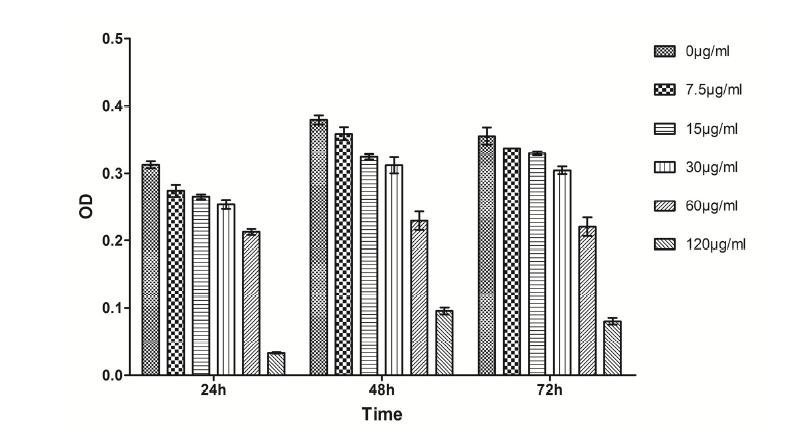 Figure 1. The Time‑OD relationship between different concentrations of Artesunate and VSMCs. The OD decreases with increasing time and concentration.
Figure 1. The Time‑OD relationship between different concentrations of Artesunate and VSMCs. The OD decreases with increasing time and concentration.
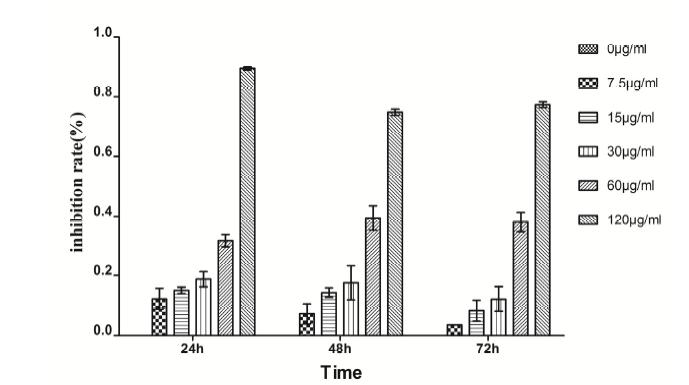 Figure 2. The time–inhibition ratio relationship between different concentrations of Artesunate and VSMCs. The apoptosis rate of VSMCs gradually increased with the increasing time and concentration.
Figure 2. The time–inhibition ratio relationship between different concentrations of Artesunate and VSMCs. The apoptosis rate of VSMCs gradually increased with the increasing time and concentration.
According to the experimental results obtained by the MTT study after treatment of VSMCs with 80 μg/mL Artesunate for 48 hours, the cell apoptosis was observed by TEM (Figure 3A): the cell volume was reduced, the cytoplasm was concentrated, nuclear chromatin was agglutinated inside the cell nuclear envelope appearing as a ring, however, the cell membrane integrity was disrupted and corrugativus. Apoptotic bodies of nuclear debris and organelles wrapped by membrane could be observed in some cells, whereas the VSMCs of the control group without drug treatment showed regular cell morphology, with evenly distributed chromatin (Figure 3B).
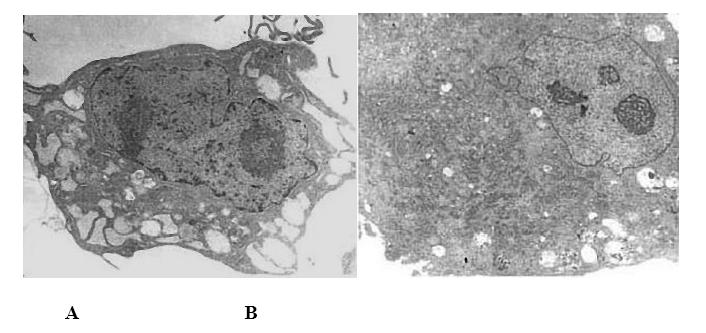 Figure 3. Results obtained by the MTT study after treatment of VSMCs with 80 μg/mL Artesunate for 48 hours, the cell apoptosis was observed by TEM. (A) After VSMCs were treated with Artesunate (80 µ g/mL) for 48 hours, the cell volume was reduced, the cell membrane was corrugativus, the cytoplasm was concentrated, and nuclear chromatin was agglutinated (TEM 6000 ×). (B) The VSMCs of the control group without drug treatment showed regular cell morphology, with evenly distributed chromatin (TEM 4000 ×).
Figure 3. Results obtained by the MTT study after treatment of VSMCs with 80 μg/mL Artesunate for 48 hours, the cell apoptosis was observed by TEM. (A) After VSMCs were treated with Artesunate (80 µ g/mL) for 48 hours, the cell volume was reduced, the cell membrane was corrugativus, the cytoplasm was concentrated, and nuclear chromatin was agglutinated (TEM 6000 ×). (B) The VSMCs of the control group without drug treatment showed regular cell morphology, with evenly distributed chromatin (TEM 4000 ×).
As shown in the picture, in the flow-test histogram, for the VSMCs treated with Artesunate, the Sub G1 phase peak appears as a typical subdiploid peak, apoptosis peak (Figure 4). In addition, the quantitative test results of the flow cytometry show that after being treated with different concentrations of Artesunate for 48 hours, the cell cycles and apoptosis rates of VSMCs have noticeable changes. With the increasing of Artesunate concentration, the number of cells in the S-phase tremendously increases and the cells in the G2 phase exceedingly reduce, which indicates that cells are mostly arrested in the S phase; the results showed a certain degree of concentration dependency (Figure 5); the apoptosis rate of VSMCs gradually increased with the increasing of Artesunate concentration. There was a considerable difference compared with the control group (P < 0.01), and when the Artesunate concentration is 120 μg/mL, the apoptosis rate reaches up to 42.81 %, showing concentration dependency (Figure 6). After adding the caspase-3 protease-specific inhibitor Ac-DEVD-CHO, the apoptosis rate of VSMCs dropped, with a distinct deviation compared with the Artesunate group (Figure 7).
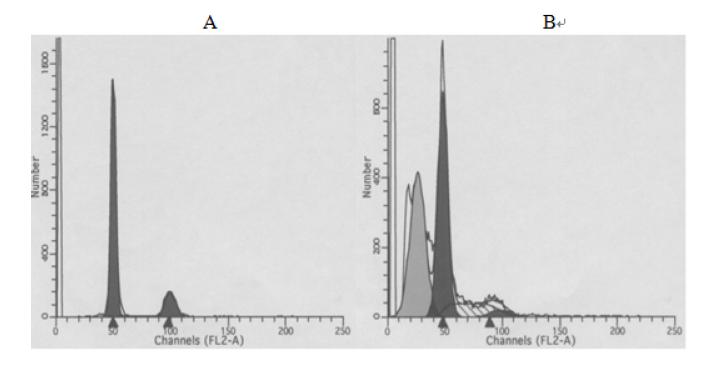 Figure 4. Typical apoptotic peak appeared after VSMCs were treated with Artesunate (120 µ g/mL) for 48 hours. (A) Control group. (B) After the VSMCs treated with Artesunate, the Sub G1 phase peak appears apoptosis peak.
Figure 4. Typical apoptotic peak appeared after VSMCs were treated with Artesunate (120 µ g/mL) for 48 hours. (A) Control group. (B) After the VSMCs treated with Artesunate, the Sub G1 phase peak appears apoptosis peak.
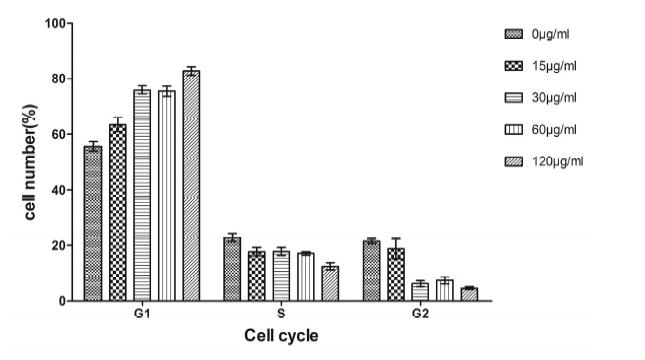 Figure 5. Changes in the cell cycle of VSMCs at different concentrations of Artesunate. After treated with Artesunate, the VSMCs are mostly arrested in the S phase.
Figure 5. Changes in the cell cycle of VSMCs at different concentrations of Artesunate. After treated with Artesunate, the VSMCs are mostly arrested in the S phase.
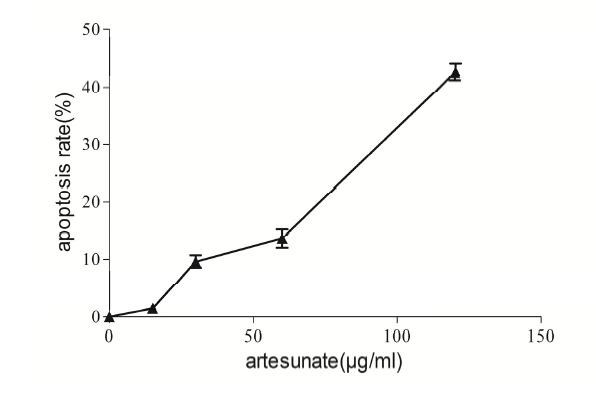 Figure 6. Changes in the apoptosis rate of VSMCs at different concentrations of Artesunate. The apoptosis rate increased with the increasing concentration of Artesunate.
Figure 6. Changes in the apoptosis rate of VSMCs at different concentrations of Artesunate. The apoptosis rate increased with the increasing concentration of Artesunate.
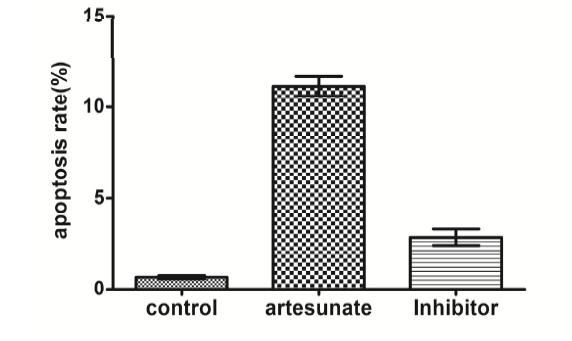 Figure 7. Changes in the apoptosis rate of VSMCs treated with Artesunate and Ac-DEVD-CHO. The results showed the apoptosis rate of VSMCs increased after treated with Artesunate (40µ g/mL) for 48 hours (Artesunate group), and pretreatment with Ac-DEVD-CHO (100µ mol/L) for 48 hours (Inhibitor group), the apoptosis rate decreased.
Figure 7. Changes in the apoptosis rate of VSMCs treated with Artesunate and Ac-DEVD-CHO. The results showed the apoptosis rate of VSMCs increased after treated with Artesunate (40µ g/mL) for 48 hours (Artesunate group), and pretreatment with Ac-DEVD-CHO (100µ mol/L) for 48 hours (Inhibitor group), the apoptosis rate decreased.
Compared with the control group, the activity of caspase-3 abnormally increased after being treated with Artesunate at a concentration of 40 μg/mL (P < 0.01), as presented in the results of the Western blot (Figure 8); however, after pretreatment with Ac-DEVD-CHO, the expression level of caspase-3 decreased deeply compared with the Artesunate-induced group, having a major deviation (P < 0.05). It indicates that Artesunate induces apoptosis by activating the proteolytic enzyme caspase-3.
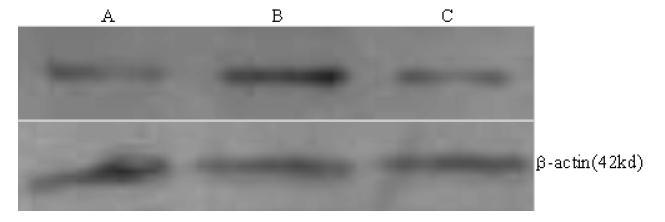 Figure 8. Effects of Ac-DEVD-CHO on the level of caspase-3 expression. (A) Control group. (B) The activity of caspase-3 significantly increased after being treated with Artesunate at a concentration of 40 μg/mL for 48 hours (P < 0.01). (C) After pretreatment with Ac-DEVD-CHO, the expression level of caspase-3 decreased significantly compared with the Artesunate-induced group (P < 0.05).
Figure 8. Effects of Ac-DEVD-CHO on the level of caspase-3 expression. (A) Control group. (B) The activity of caspase-3 significantly increased after being treated with Artesunate at a concentration of 40 μg/mL for 48 hours (P < 0.01). (C) After pretreatment with Ac-DEVD-CHO, the expression level of caspase-3 decreased significantly compared with the Artesunate-induced group (P < 0.05).
Previous report has shown that VSMC proliferation was inhibited and apoptosis was increased in a concentration-dependent manner after treatment with Artesunate and that the cell cycle was arrested in the sub G1 phase [16]. In this study, MTT results showed VSMC proliferation was inhibited by Artesunate, which was consistent with previous result. The cell cycle detected by flow cytometry indicated that the S-phase ratio in VSMCs increased gradually as the concentration of Artesunate increased and the G2 phase reduced, and there are attractive differences compared with the control group. What was more, we found cells were prevented from entering the G2/M phase and stagnated at the G1/S phase, which differed from previous findings [16], thereby indicating that the control points of Artesunate on the cell cycle of VSMCs were not unique but both: the G1/S phase and the G2/M phase, and they interfered with the DNA synthesis of VSMCs to inhibit the proliferation of VSMCs. We also found that, in the range of 15 ‒ 120 μg/mL Artesunate, the apoptosis rate of VSMCs increased in a concentration-dependent manner, and the effects of high-dose Artesunate on the inhibition of cell proliferation and induction of cell apoptosis were impressive (P < 0.01).
Apoptosis is caused by the activation of a series of intracellular proteolytic enzymes [17,18,19,20,21], among which caspase-dependent apoptosis was the earliest to be recognized. There are at least three ways of caspase activation: mitochondria/cyt-c pathway, death-receptor pathway, and endoplasmic reticulum pathway. Rinner et al. [15] consider that Artesunate-induced apoptosis may be caused by the caspase-3 pathway. Ac-DEVD-CHO is a very strong inhibitor of caspase-3, which can inhibit the apoptosis caused by activation of caspase-3 [22,23]. In this study, Western blot results pronounced that, after the VSMCs were treated with 40 μg/mL Artesunate for 48 hours, the activity of caspase-3 was strikingly increased compared with the control group (P < 0.01), whereas, after being pretreated with 100 μg/mL Ac-DEVD-CHO for 48 hours, the activity of caspase-3 (induced by Artesunate) was greatly inhibited. Flow cytometry results indicated that the apoptosis rate was significantly reduced (P < 0.01). Therefore, it was confirmed that Artesunate can induce the apoptosis of VSMCs by activating the caspase-3 pathway.
Understanding the mechanisms that Artesunate induce VSMCs apoptosis has some implications for rational utility of Artesunate-related drugs. Recent reports have suggested that Ras-PI3K-Akt pathway played important role in Artesunate-induced VSMCs apoptosis [19], the ERK1/2 expression, p-Akt and caspase-9 activities were examined in the Ras signaling pathway. Their results showed that Artesunate reduced ERK1/2 and p-Akt expression in a concentration-dependent manner, and promoted the activation of caspase-9. Combined with the results of our study, we pointed out that Artesunate may promote the apoptosis of VSMCs by inhibiting the Ras-PI3K-Akt pathway and initiating the depolarization of inner mitochondrial membrane.
Interestingly, we found that caspase inhibitor Ac-DEVD-CHO did not inhibit apoptosis of VSMCs completely (Figure 8), raising the possibility that other pathways were also involved in Artesunate-induced VSMCs apoptosis in addition to the caspase pathway, further studies are needed to identify the precise mechanism.
Caspase-3 inhibitor Ac-DEVD-CHO can significantly inhibit the vascular smooth muscle cell proliferation and apoptosis induced by Artesunate and caspase-3 activates, reveal the mitochondria apoptotic pathway is the main mechanism that Artesunate promote the apoptosis of vascular smooth muscle cells.
These studies were supported by grants from the National Natural Science Foundation of China (11332003, 31370949), the National Key Technology R & D Program of China (2012BAI18B02) and the National “111 plan” Base (B06023) as well as the Public Experiment Center of State Bioindustrial Base (Chongqing), China.
The authors declare that they have no competing interests.
| [1] |
Clarke MC, Figg N, Maguire JJ, et al. (2006) Apoptosis of vascular smooth muscle cells induces features of plaque vulnerability in atherosclerosis. Nat Med 12: 1075-1080. doi: 10.1038/nm1459

|
| [2] |
Scott S, O'Sullivan M, Hafizi S, et al. (2002) Human vascular smooth muscle cells from restenosis or in-stent stenosis sites demonstrate enhanced responses to p53: implications for brachytherapy and drug treatment for restenosis. Circ Res 90: 398-404. doi: 10.1161/hh0402.105900

|
| [3] |
Erl W (2005) Statin-induced vascular smooth muscle cell apoptosis: a possible role in the prevention of restenosis? Curr Drug Targets Cardiovasc Haematol Disord 5: 135-144. doi: 10.2174/1568006043586134

|
| [4] | Liu X (2006) Recent development of Artesunate. Chinese Journal of New Drugs 15:1918-1923. |
| [5] |
Chen HH, Zhou HJ, Wu GD, et al. (2004) Inhibitory effects of Artesunate on angiogenesis and on expressions of vascular endothelial growth factor and VEGF receptor KDR/flk-1. Pharmacology 71: 1-9. doi: 10.1159/000076256

|
| [6] | Berger TG, Dieckmann D, Efferth T, et al. (2005) Artesunate in the treatment of metastatic uveal melanoma——first experiences. Oncol Rep 14: 1599-1603. |
| [7] |
Wu GD, Zhou HJ, Wu XH, et al. (2004) Apoptosis of human umbilical vein endothelial cells induced by artesunate. Vascul Pharmacol 41: 205-212. doi: 10.1016/j.vph.2004.11.001

|
| [8] |
He RR, Zhou HJ (2008) Progress in research on the anti-tumor effect of Artesunate. Chin J Integr Med 14: 312-316. doi: 10.1007/s11655-008-0312-0

|
| [9] |
Li S, Xue F, Cheng Z, et al. (2009) Effect of Artesunate on inhibiting proliferation and inducing apoptosis of SP2/0 myeloma cells through affecting NFkappaB p65. Int J Hematol 90: 513-521. doi: 10.1007/s12185-009-0409-z

|
| [10] | Zheng JS, Wang MH, Huang M, et al. (2008) Artesunate suppresses human endometrial carcinoma RL95-2 cell proliferation by inducing cell apoptosis. Nan Fang Yi Ke Da Xue Xue Bao 28: 2221-2223. |
| [11] |
Hou J, Wang D, Zhang R, et al. (2008) Experimental therapy of hepatoma with artemisinin and its derivatives: in vitro and in vivo activity, chemosensitization, and mechanisms of action. Clin Cancer Res 14: 5519-5530. doi: 10.1158/1078-0432.CCR-08-0197

|
| [12] | Sieber S, Gdynia G, Roth W, et al. (2009) Combination treatment of malignant B cells using the anti-CD20 antibody rituximab and the anti-malarial Artesunate. Int J Oncol 35: 149-158. |
| [13] |
Xiao SH, Mei JY, Jiao PY (2011) Effect of mefloquine administered orally at single, multiple, or combined with artemether, Artesunate, or praziquantel in treatment of mice infected with Schistosoma japonicum. Parasitol Res 108: 399-406. doi: 10.1007/s00436-010-2080-y

|
| [14] |
Keiser J, Xiao S, Smith TA, et al. (2009) Combination Chemotherapy against Clonorchis sinensis: Experiments with Artemether, Artesunate, OZ78, Praziquantel, and Tribendimidine in a Rat Model. Antimicrob Agents Chemother 53: 3770-3776. doi: 10.1128/AAC.00452-09

|
| [15] | Rinner B, Siegl V, Pürstner P, et al. (2004) Activity of novel plant extracts against medullary thyroid carcinoma cells. Anticancer Res 24: 495-500. |
| [16] |
Zhou Z, Feng Y (2005) Artesunate reduces proliferation, interferes DNA replication and cell cycle and enhances apoptosis in vascular smooth muscle cells. J Huazhong Univ Sci Technolog Med Sci 25: 135-136. doi: 10.1007/BF02873558

|
| [17] | Liao H (2006) Effects of Artesunate on the the proliferation and apoptosis of rat aortic vascular smooth muscle cells in vitro. Huazhong University of Science and Technology [Ph.D Dissertation]. |
| [18] |
Pan W, da Graca LS, Shao Y, et al. (2009) PHAPI/pp32 suppresses tumorigenesis by stimulating apoptosis. J Biol Chem 284: 6946-6954. doi: 10.1074/jbc.M805801200

|
| [19] |
LuYY, Chen TS, Qu JL, et al. (2009) Dihydroartemisinin (DHA) induces caspase-3-dependent apoptosis in human lung adenocarcinoma ASTC-a-1 cells. J Biomed Sci 16:16. doi: 10.1186/1423-0127-16-16

|
| [20] |
Bratton SB, MacFarlane M, Cain K, et al. (2000) Protein complexes activate distinct caspase cascades in death receptor and stress-induced apoptosis. Exp Cell Res 256: 27-33. doi: 10.1006/excr.2000.4835

|
| [21] |
Cho SG, Choi EJ (2002) Apoptotic signaling pathways: caspases and stress-activated protein kinases. J Biochem Mol Biol 35: 24-27. doi: 10.5483/BMBRep.2002.35.1.024

|
| [22] |
Enari M, Sakahira H, Yokoyama H, et al. (1998) A caspase-activated DNase that degrades DNA during apoptosis, and its inhibitor ICAD. Nature 391: 43-50. doi: 10.1038/34112

|
| [23] |
Korn C, Scholz SR, Gimadutdinow O, et al. (2002) Involvement of conserved histidine, lysine and tyrosine residues in the mechanism of DNA cleavage by the caspase-3 activated DNase CAD. Nucleic Acids Res 30: 1325-1332. doi: 10.1093/nar/30.6.1325

|
| 1. | Xiong Xin, Ding Ning, Zhuang Shuai, Dou Peipei, Feng Ruifang, Tan Yuqing, Ma Huawei, Chen Lin, Hong Hui, Luo Yongkang, Caspase-3 interactions with calpain and cathepsin L: Implications for protein stability and quality in fish fillets during postmortem storage, 2024, 61, 22124292, 104709, 10.1016/j.fbio.2024.104709 |